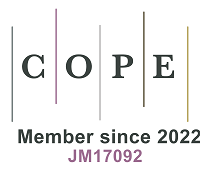REFERENCES
1. Fujii, H.; Managi, S. Economic development and multiple air pollutant emissions from the industrial sector. Environ. Sci. Pollut. Res. Int. 2016, 23, 2802-12.
2. Kelly, F. J.; Fussell, J. C. Air pollution and public health: emerging hazards and improved understanding of risk. Environ. Geochem. Health. 2015, 37, 631-49.
3. Manisalidis, I.; Stavropoulou, E.; Stavropoulos, A.; Bezirtzoglou, E. Environmental and health impacts of air pollution: a review. Front. Public. Health. 2020, 8, 14.
4. Holme, J. A.; Vondráček, J.; Machala, M.; et al. Lung cancer associated with combustion particles and fine particulate matter (PM2.5) - the roles of polycyclic aromatic hydrocarbons (PAHs) and the aryl hydrocarbon receptor (AhR). Biochem. Pharmacol. 2023, 216, 115801.
5. Molina, L.; Segura, A. Biochemical and metabolic plant responses toward polycyclic aromatic hydrocarbons and heavy metals present in atmospheric pollution. Plants. (Basel). 2021, 10, 2305.
6. Morakinyo, O. M.; Mokgobu, M. I.; Mukhola, M. S.; Hunter, R. P. Health outcomes of exposure to biological and chemical components of inhalable and respirable particulate matter. Int. J. Environ. Res. Public. Health. 2016, 13, 592.
7. Valavanidis, A.; Fiotakis, K.; Vlachogianni, T. Airborne particulate matter and human health: toxicological assessment and importance of size and composition of particles for oxidative damage and carcinogenic mechanisms. J. Environ. Sci. Health. C. Environ. Carcinog. Ecotoxicol. Rev. 2008, 26, 339-62.
8. Bauleo, L.; Bucci, S.; Antonucci, C.; et al. Long-term exposure to air pollutants from multiple sources and mortality in an industrial area: a cohort study. Occup. Environ. Med. 2019, 76, 48-57.
9. Fang, S. C.; Cassidy, A.; Christiani, D. C. A systematic review of occupational exposure to particulate matter and cardiovascular disease. Int. J. Environ. Res. Public. Health. 2010, 7, 1773-806.
10. Waidyatillake, N. T.; Campbell, P. T.; Vicendese, D.; Dharmage, S. C.; Curto, A.; Stevenson, M. Particulate matter and premature mortality: a Bayesian meta-analysis. Int. J. Environ. Res. Public. Health. 2021, 18, 7655.
12. Apte, J. S.; Brauer, M.; Cohen, A. J.; Ezzati, M.; Pope, C. A. Ambient PM2.5 reduces global and regional life expectancy. Environ. Sci. Technol. Lett. 2018, 5, 546-51.
13. Kumar, S.; Jain, M. K. Interrelationship of indoor particulate matter and respiratory dust depositions of women in the residence of Dhanbad City, India. Environ. Sci. Pollut. Res. Int. 2022, 29, 4668-89.
14. World Health Organization (WHO). WHO Global Air Quality Guidelines: Particulate Matter (PM2.5 and PM10), ozone, nitrogen dioxide, sulfur dioxide, and carbon monoxide. 2021. Available from: https://www.who.int/publications/i/item/9789240034228/ (accessed on 2025-9-15).
15. Silveira Fleck A, Sadoine ML, Buteau S, Suarthana E, Debia M, Smargiassi A. Environmental and occupational short-term exposure to airborne particles and FEV(1) and FVC in healthy adults: a systematic review and meta-analysis. Int. J. Environ. Res. Public. Health. 2021, 18, 10571.
16. Sekhavati, E.; Yengejeh, R. J. Particulate matter exposure in construction sites is associated with health effects in workers. Front. Public. Health. 2023, 11, 1130620.
17. Jean-Jacques, S.; Simon, D.; Ferdinand, S.; Michael, R. Oxidative potential of particles in different occupational environments: a pilot study. Ann. Occup. Hyg. 2015, 59, 882-94.
18. Shezi, B.; Mathee, A.; Cele, N.; Ndabandaba, S.; Street, R. A. Occupational exposure to fine particulate matter (PM4 and PM2.5) during hand-made cookware operation: personal, indoor and outdoor levels. Int. J. Environ. Res. Public. Health. 2020, 17, 7522.
19. Ali, M. U.; Lin, S.; Yousaf, B.; et al. Pollution characteristics, mechanism of toxicity and health effects of the ultrafine particles in the indoor environment: current status and future perspectives. Crit. Rev. Environ. Sci. Technol. 2022, 52, 436-73.
20. Moreno-Rangel, A.; Sharpe, T.; McGill, G.; Musau, F. Indoor air quality in passivhaus dwellings: a literature review. Int. J. Environ. Res. Public. Health. 2020, 17, 4749.
21. Zhang, M.; Gong, Y.; Huang, H.; Hu, H. Seasonal variation of water-soluble inorganic ions and carbonaceous components of PM2.5 and PM1 in industrial and residential areas of Suizhou, China. Atmos. Pollut. Res. 2024, 15, 102276.
22. Abdillah, S. F. I.; Wang, Y. F. Ambient ultrafine particle (PM0.1): sources, characteristics, measurements and exposure implications on human health. Environ. Res. 2023, 218, 115061.
23. Casquero-Vera, J. A.; Lyamani, H.; Titos, G.; et al. Quantifying traffic, biomass burning and secondary source contributions to atmospheric particle number concentrations at urban and suburban sites. Sci. Total. Environ. 2021, 768, 145282.
24. Li, C.; Han, D.; Wei, X.; Yang, J.; Wu, C. Health Risk Assessment of inhalable dust exposure during the welding and grinding process of subway aluminum alloy components. Buildings 2023, 13, 2469.
25. Rahman, M. M.; Mazaheri, M.; Clifford, S.; Morawska, L. Estimate of main local sources to ambient ultrafine particle number concentrations in an urban area. Atmospheric. Research. 2017, 194, 178-89.
26. Hong, G.; Jee, Y. K. Special issue on ultrafine particles: where are they from and how do they affect us? Exp. Mol. Med. 2020, 52, 309-10.
27. Kwon, H. S.; Ryu, M. H.; Carlsten, C. Ultrafine particles: unique physicochemical properties relevant to health and disease. Exp. Mol. Med. 2020, 52, 318-28.
28. Lai, C. H.; Lin, C. H.; Liao, C. C.; Chuang, K. Y.; Peng, Y. P. Effects of heavy metals on health risk and characteristic in surrounding atmosphere of tire manufacturing plant, Taiwan. RSC. Adv. 2018, 8, 3041-50.
29. Crépeaux, G.; Eidi, H.; David, M. O.; et al. Non-linear dose-response of aluminium hydroxide adjuvant particles: selective low dose neurotoxicity. Toxicology 2017, 375, 48-57.
30. Gaidajis, G.; Angelakoglou, K.; Gazea, E. Ambient air quality at the wider area of an industrial mining facility at Stratoni, Chalkidiki, Greece. J. Environ. Sci. Health. A. Tox. Hazard. Subst. Environ. Eng. 2012, 47, 1869-77.
31. Higashikubo, I.; Handika, R. A.; Kawamoto, T.; et al. Worker's personal exposure to PM0.1 and PM4 titanium dioxide nanomaterials during packaging. Aerosol. Air. Qual. Res. 2021, 21, 200606.
32. Mutua, A. M.; Mwangi, K.; Abubakar, A.; Atkinson, S. H. Effects of iron intake on neurobehavioural outcomes in African children: a systematic review and meta-analysis of randomised controlled trials. Wellcome. Open. Res. 2021, 6, 181.
33. Salih, Z.; Aziz, F. Heavy metal accumulation in dust and workers’ scalp hair as a bioindicator for air pollution from a steel factory. Pol. J. Environ. Stud. 2020, 29, 1805-13.
34. Kong, N.; Chen, G.; Wang, H.; et al. Blood leukocyte count as a systemic inflammatory biomarker associated with a more rapid spirometric decline in a large cohort of iron and steel industry workers. Respir. Res. 2021, 22, 254.
35. Kornberg, T. G.; Stueckle, T. A.; Antonini, J. A.; et al. Potential toxicity and underlying mechanisms associated with pulmonary exposure to iron oxide nanoparticles: conflicting literature and unclear risk. Nanomaterials. (Basel). 2017, 7, 307.
36. Langevin, S. M.; McClean, M. D.; Michaud, D. S.; Eliot, M.; Nelson, H. H.; Kelsey, K. T. Occupational dust exposure and head and neck squamous cell carcinoma risk in a population-based case-control study conducted in the greater Boston area. Cancer. Med. 2013, 2, 978-86.
37. Nakadate, T.; Yamano, Y.; Adachi, C.; et al. A cross sectional study of the respiratory health of workers handling printing toner dust. Occup. Environ. Med. 2006, 63, 244-9.
38. Susihono, W.; Gede, Adiatmika. I. P. Assessment of inhaled dust by workers and suspended dust for pollution control change and ergonomic intervention in metal casting industry: A cross-sectional study. Heliyon 2020, 6, e04067.
39. Szűcs-Somlyó, É.; Lehel, J.; Májlinger, K.; Tóth, F.; Jerzsele, Á.; Kővágó, C. Immune response to zinc oxide inhalation in metal fume fever, and the possible role of IL-17f. Sci. Rep. 2023, 13, 22239.
40. Vella, F.; Filetti, V.; Matera, S.; et al. Risk of pneumoconiosis in workers exposed to crystalline silica from lava rock dust from Mount Etna. J. Clin. Med. 2025, 14, 3781.
41. Otani, Y.; Eryu, K.; Furuuchi, M.; Tajima, N.; Tekasakul, P. Inertial classification of nanoparticles with fibrous filters. Aerosol. Air. Qual. Res. 2007, 7, 343-52.
42. Furuuchi, M.; Choosong, T.; Hata, M.; et al. Development of a personal sampler for evaluating exposure to ultrafine particles. Aerosol. Air. Qual. Res. 2010, 10, 30-7.
43. Amin, M.; Putri, R. M.; Handika, R. A.; et al. Size-segregated particulate matter down to PM0.1 and carbon content during the rainy and dry seasons in Sumatra Island, Indonesia. Atmosphere 2021, 12, 1441.
44. Putri, R. M.; Amin, M.; Suciari, T. F.; et al. Site-specific variation in mass concentration and chemical components in ambient nanoparticles (PM0.1) in North Sumatra Province-Indonesia. Atmos. Pollut. Res. 2021, 12, 101062.
45. Chang, L. P.; Tsai, J. H.; Chang, K. L.; Lin, J. J. Water-soluble inorganic ions in airborne particulates from the nano to coarse mode: a case study of aerosol episodes in southern region of Taiwan. Environ. Geochem. Health. 2008, 30, 291-303.
46. Chang, C.; Demokritou, P.; Shafer, M.; Christiani, D. Physicochemical and toxicological characteristics of welding fume derived particles generated from real time welding processes. Environ. Sci. Process. Impacts. 2013, 15, 214-24.
47. Abdullahi, I. L.; Sani, A. Welding fumes composition and their effects on blood heavy metals in albino rats. Toxicol. Rep. 2020, 7, 1495-501.
48. Liu, H.; Huang, F.; Yuan, W.; Hu, Q.; Liu, J.; Cheng, Y. F. Essential role of element Si in corrosion resistance of a bridge steel in chloride atmosphere. Corros. Sci. 2020, 173, 108758.
49. Cunat, P. J. Alloying elements in stainless steel and other chromium-containing alloys. Available from: chrome-extension://efaidnbmnnnibpcajpcglclefindmkaj/https://worldstainless.org/wp-content/uploads/2025/02/alloying-elements.pdf (accessed on 2025-9-15).
50. Ghosh, B.; Padhy, P. K.; Niyogi, S.; Patra, P. K.; Hecker, M. A comparative study of heavy metal pollution in ambient air and the health risks assessment in industrial, urban and semi-urban areas of West Bengal, India: an evaluation of carcinogenic, non-carcinogenic, and additional lifetime cancer cases. Environments 2023, 10, 190.
51. Sadheesh, S.; Malathi, R.; Arundhathi,
52. Amari, A.; Momen, A.; Rostami, R. A systematic review on concentration of heavy metal in the ambient air of different industries and the health risk assessment. ACT 2023, 8.
53. Zhang, X.; Sun, M.; Aikawa, M. Characteristics of PM2.5-bound metals in Japan over six years: spatial distribution, health risk, and source analysis. J. Environ. Manage. 2023, 344, 118750.
54. Gonzalez-Villalva, A.; Marcela, R. L.; Nelly, L. V.; et al. Lead systemic toxicity: a persistent problem for health. Toxicology 2025, 515, 154163.
55. Maria, H.; Jessica, A.; Gabriella, E.; Aprillia, C.; Yudiarso, A. Impact of Lead (Pb) on Health. JGRPH 2025, 10, 1-14.
56. Lucchini, R.; Tieu, K. Manganese-induced parkinsonism: evidence from epidemiological and experimental studies. Biomolecules 2023, 13, 1190.







